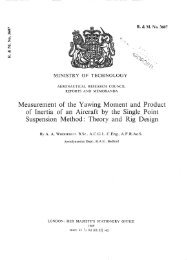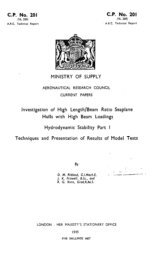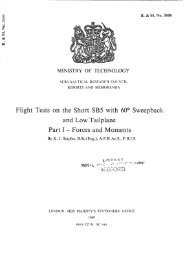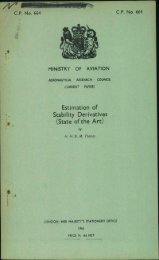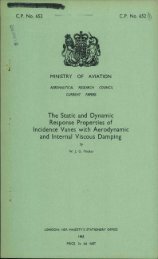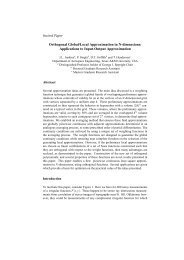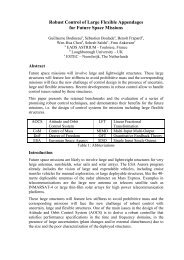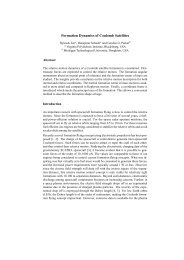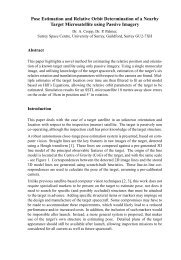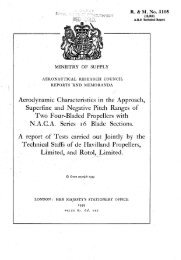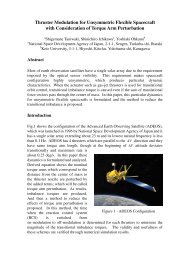The Aerodynamic Characteristics of Flaps
The Aerodynamic Characteristics of Flaps
The Aerodynamic Characteristics of Flaps
You also want an ePaper? Increase the reach of your titles
YUMPU automatically turns print PDFs into web optimized ePapers that Google loves.
Blackburn Aircraft Ltd. have tested leading-edge slats on 0-4c and 0.5c chord flaps. <strong>The</strong> main<br />
data for the two most promising arrangements are given in Table 2. For the 0-4c flap it was found<br />
advisable to use a relatively large slat to get a marked improvement <strong>of</strong> lift. <strong>The</strong> estimated value<br />
<strong>of</strong> d CL' in Table 2 was arrived at by treatingthe flap plus slat as a single-slotted flap with the<br />
leading edge at the nose <strong>of</strong> tile slat, thus, the estimate includes the effect <strong>of</strong> chord and flap extension<br />
due to the slat, but not the effect <strong>of</strong> flow improvement over the flap. A comparison <strong>of</strong><br />
the estimated and measured values <strong>of</strong> A CL' for the 0.4c flap shows that in this case there could<br />
have been no appreciable flow improvement. In the case <strong>of</strong> the 0.5c flap, however, the leadingedge<br />
slat, although small, produced a marked increase in the lift increment, a considerable portion<br />
<strong>of</strong> which must have been due to the resulting improvement <strong>of</strong> flow over the flap. It is <strong>of</strong> interest<br />
to note that because <strong>of</strong> this improvement tile drag increment for the optimum setting is relatively<br />
small. <strong>The</strong> value <strong>of</strong> A C,,,~/A CL is about --0.35, but A C,,~',/A CL' is in the usual low range for<br />
Blackburn flaps, viz., --0.19 to --0.24.<br />
6.5.4. Blackburn flap with inset slots (Fig. lm).--An obviously related device, that was also<br />
tested by Blackburn Aircraft Ltd., is that <strong>of</strong> a flap with fixed inset slots 69, 70. If the slots are<br />
efficiently designed, then, like the flap leading-edge slat, they produce a general improvement<br />
<strong>of</strong> the flow over the flap. <strong>The</strong> important data for the optimum cases tested are given in Table 2.<br />
<strong>The</strong> cleaning up effect <strong>of</strong> the slot on the flow over the flap is indicated by the fact that in each case<br />
the measured value <strong>of</strong> A CL' is considerably greater than the estimated value, whilst the value<br />
<strong>of</strong> A Coo is small for the A CL obtained. <strong>The</strong> values <strong>of</strong> -- (A C,,r/A CL) are 0.29 and 0.35 for tile<br />
wing with 0.4c and 0.5c flaps respectively, but --(A C,,/,/A CL') varies between the limits 0.225<br />
and 0.25.<br />
<strong>The</strong> simplicity <strong>of</strong> this device is largely <strong>of</strong>fset by the fact that unless the slot or slots are sealed<br />
when the flap is retracted, they will cause a serious increase <strong>of</strong> drag. <strong>The</strong> tests indicated that for<br />
a slot to function properly it must be cut at a fairly small angle (about 20 deg) to the flap chord.<br />
Hence the opening on the upper surface must occur well back, and it will be very difficult to increase<br />
the shroud sufficiently to seal the slot.<br />
6.5.5. Blackburn flap with deflected shroud (Fig. In).--One <strong>of</strong> the most effective devices tested<br />
by Blackburn Aircraft Ltd. consists <strong>of</strong> a slotted flap with a slightly longer shroud than usual,<br />
and part <strong>of</strong> the shroud is hinged and arranged to deflect downwards with the flap 69. <strong>The</strong> shroud<br />
thus smooths over the effective change <strong>of</strong> camber involved in putting the flap down, and in fact<br />
the combination <strong>of</strong> deflected shroud and flap acts as a double flap. <strong>The</strong> main data are given in<br />
Table 2. <strong>The</strong> lift coefficient increment attained (2.26) is only slightly less than that attained<br />
with either inset slots or a flap leading edge slat, and it probably presents less serious disadvantages<br />
than these other devices.<br />
Treating it as a double-slotted flap the estimated value <strong>of</strong> A CL' is almost in exact agreement<br />
with the measured value. If we regard it as a plain front flap and a rear slotted flap the estimated<br />
value <strong>of</strong> A CL' is appreciably less than the measured value. This is not surprising, since the slot<br />
is near enough to tile shroud hinge to dominate the flow there. Tile pitching moment coefficient<br />
increments are relatively small, A C,n,/A CL is --0.3, whilst A C,,',/A CL' is --0.18.<br />
6.6. Venetian-blind <strong>Flaps</strong> (Fig. lo).--Venetian-blind flaps have at various times aroused a<br />
certain amount <strong>of</strong> interest, since, if their slots function properly, their lift increments should<br />
approach the theoretical plain flap values. <strong>The</strong> results <strong>of</strong> such tests as have been made, however,<br />
have been rather disappointing 77,78 Representative data are included in Table 2. <strong>The</strong> main<br />
conclusions <strong>of</strong> these tests are :--<br />
(1) <strong>The</strong> optimum spacing <strong>of</strong> the slat components appears to be one slat-ch0rd length and<br />
there is no advantage in using a large number <strong>of</strong> small slats rather than a small<br />
number <strong>of</strong> large slats.<br />
17



